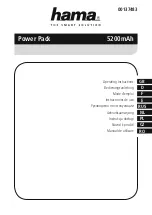
2.5 Output voltage adjustment range
2.6 Isolation
2.7 Remote ON/OFF (”-R”)
n
n
n
n
n
n
n
n
n
n
Adjustment of output voltage is possible by using potentiometer
(only available to 3V output voltage type).
Output voltage is increased by turning potentiometer clockwise
and is decreased by turning potentiometer counterclockwise.
Option ”-Y” is recommended which can adjust the output voltage.
Adjustment of output voltage is possible by using potentiometer
(only available to 3 and 5V output voltage type).
Output voltage is increased by turning potentiometer clockwise
and is decreased by turning potentiometer counterclockwise.
Option unit ”-Y” is recommended which can adjust the output volt-
age.
Adjustment of output voltage is possible by using potentiometer.
Output voltage is increased by turning potentiometer clockwise
and is decreased by turning potentiometer counterclockwise.
For a receiving inspection, such as Hi-Pot
test, gradually in-
crease (decrease) the voltage for the start (shut down). Avoid us-
ing Hi-Pot tester with the timer because it may generate voltage a
few times higher than the applied voltage, at ON/OFF of a timer.
If the unit is tested on the isolation between input & output and
output & FG, remote ON/OFF must be shorted to output .
Option ”-R” is available for remote ON/OFF.
l
l
l
l
LDA10F - LDA75F
LDA100W LDA150W
LDA300W
LDA50F - LDA300W
n
When external power source is in the range of 4.5 - 12V
(LDA300W : 4.5 - 12.5V), current limit resistance R is not re-
quired. However, when external power source exceeds 12V
(LDA300W : 12.5V), current limit resistance R must be con-
nected.
To calculate the current limit resistance use following equation:
Vcc-(1.1+ Ri
0.005)
R[ ]=
0.005
where:
Vcc = External power source
Ri
= The internal resistance (see table)
n
n
n
n
n
n
n
n
n
A wrong connection may damage the internal components of the
unit.
Remote ON/OFF circuit (RC(+), RC(-)) is isolated from input, out-
put and FG.
When not using this function, confirm that terminals are shorted
bS and +M, and between -S and -M with short pieces.
When using this function, wiring should be done without short
pieces.
Devices inside the power supply might be damaged when poor
connection on load lines occurs, e.g. because of loose connector
screws.
Thick wire should be used for wiring between power supply and
load, and line voltage drop should be less than 0.3V.
When long sensing wire is required, use C.
Twisted-pair wire or shield wire should be used for sensing wire.
When remote sensing function is used, output voltage might be-
come unstable because of a impedance of wiring and load condi-
tion. And the power supply should be evaluated enough. Following
are examples to improve it.
-S sensing wire is removed and terminals between -M and -S
are shorted.
C and R are connected as above figure.
(1) When not using remote sensing function
2.8 Remote sensing
l
LDA300W
LDA-22
Between RC(+) and RC(-)
Output
SW OFF
(0 - 0.5V)
SW
ON
(4.5 - 12V)
(LDA300W : 4.5 - 12.5V)
ON
OFF
Model
LDA50F - 150W
680
780
LDA300W
Ri[ ]
LDA
Instruction Manual
AC-DC Power Supplies Open Frame/Enclosed type
June 29, 2011



























